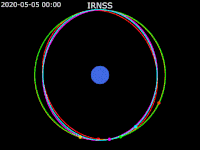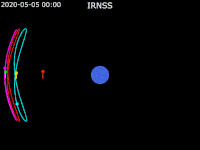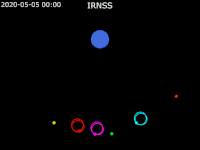
The Polar Satellite Launch Vehicle (PSLV) is an expendable medium-lift launch vehicle designed and operated by the Indian Space Research Organisation (ISRO). It was developed to allow India to launch its Indian Remote Sensing (IRS) satellites into Sun-synchronous orbits, a service that was, until the advent of the PSLV in 1993, only commercially available from Russia. PSLV can also launch small size satellites into Geostationary Transfer Orbit (GTO).

A satellite navigation or satnav system is a system that uses satellites to provide autonomous geopositioning. A satellite navigation system with global coverage is termed global navigation satellite system (GNSS). As of 2024, four global systems are operational: the United States's Global Positioning System (GPS), Russia's Global Navigation Satellite System (GLONASS), China's BeiDou Navigation Satellite System (BDS), and the European Union's Galileo.
The GPS-aided GEO augmented navigation (GAGAN) is an implementation of a regional satellite-based augmentation system (SBAS) by the Government of India. It is a system to improve the accuracy of a GNSS receiver by providing reference signals. The Airports Authority of India (AAI)'s efforts towards implementation of operational SBAS can be viewed as the first step towards introduction of modern communication, navigation and surveillance / air traffic management system over the Indian airspace.

The Indian Regional Navigation Satellite System (IRNSS), with an operational name of NavIC, is an autonomous regional satellite navigation system that provides accurate real-time positioning and timing services. It covers India and a region extending 1,500 km (930 mi) around it, with plans for further extension up to 3,000 km (1,900 mi). An extended service area lies between the primary service area and a rectangle area enclosed by the 30th parallel south to the 50th parallel north and the 30th meridian east to the 130th meridian east, 1,500–6,000 km (930–3,730 mi) beyond borders where some of the NavIC satellites are visible but the position is not always computable with assured accuracy. The system currently consists of a constellation of eight satellites, with two additional satellites on ground as stand-by.
IRNSS-1A is the first navigational satellite in the Indian Regional Navigation Satellite System (IRNSS) series of satellites been placed in geosynchronous orbit.
I-1K is a satellite bus developed by the Indian Space Research Organisation (ISRO) and marketed by Antrix Corporation. The I-1K bus is designed to be compatible with lightweight geostationary satellites and is commonly used for meteorological satellites.
IRNSS-1B is the second out of seven in the Indian Regional Navigation Satellite System (IRNSS) series of satellites after IRNSS-1A. The IRNSS constellation of satellites is slated to be launched to provide navigational services to the region. It was placed in geosynchronous orbit on 4 April 2014.
IRNSS-1C is the third out of seven in the Indian Regional Navigation Satellite System (IRNSS) series of satellites after IRNSS-1A and IRNSS-1B. The IRNSS constellation of satellites is slated to be launched to provide navigational services to the region. It was launched on 15 October 2014 at 20:02 UTC by PSLV-C26 and will be placed in geostationary orbit.
IRNSS-1D is a satellite in the Indian Regional Navigational Satellite System (IRNSS) constellation. The satellite is the fourth of seven in the constellation, launched after IRNSS-1A, IRNSS-1B and IRNSS-1C. The satellite is the only satellite in the constellation slated to provide navigational services to the region. The satellite will be placed in geosynchronous orbit. It was launched successfully on 28 March 2015 onboard ISRO's PSLV-C27 from Satish Dhawan Space Centre, Sriharikota.
IRNSS-1E is the fifth out of seven in the Indian Regional Navigational Satellite System (IRNSS) series of satellites after IRNSS-1A, IRNSS-1B, IRNSS-1C and IRNSS-1D. It is one among the seven of the IRNSS constellation of satellites launched to provide navigational services to the region. The satellite was placed in geosynchronous orbit. IRNSS-1E has been successfully launched into orbit on 20 January 2016

IRNSS-1F is the sixth navigation satellite out of seven in the Indian Regional Navigational Satellite System (IRNSS) series of satellites after IRNSS-1A, IRNSS-1B, IRNSS-1C, IRNSS-1D and IRNSS-1E. The satellite is one among the seven of the IRNSS constellation of satellites launched to provide navigational services to the region.

IRNSS-1G was the seventh and final of the Indian Regional Navigation Satellite System (IRNSS) series of satellites after IRNSS-1A, IRNSS-1B, IRNSS-1C, IRNSS-1D, IRNSS-1E and IRNSS-1F. This system of satellites will provide navigational services to the Indian region. The satellite was launched successfully on 28 April 2016 at 07:20 UTC.
Resourcesat-2A is a follow on mission to Resourcesat-1 and Resourcesat-2 which were launched in October 2003 and in April 2011 respectively. The new satellite provides the same services as the other Resourcesat missions. It will give regular micro and macro information on land and water bodies below, farm lands and crop extent, forests, mineral deposits, coastal information, rural and urban spreads besides helping in disaster management.

IRNSS-1H was the eighth in the Indian Regional Navigational Satellite System (IRNSS) series of satellites, after IRNSS-1A, IRNSS-1B, IRNSS-1C, IRNSS-1D, IRNSS-1E, IRNSS-1F and IRNSS-1G. It was lost in the launch failure of PSLV-C39 on August 31, 2017.
Polar Satellite Launch Vehicle – C39 was the forty-first flight of the PSLV series of launch vehicles on 31 August 2017. Launched in its XL configuration, the vehicle suffered a rare failure – the first failure after 24 years of operations when the heat shield failed to separate and the payload became trapped inside the heat shield and could not be deployed.

NVS-01 is the first in the series of second generation navigation satellite and the ninth satellite in the Navigation with Indian Constellation (NavIC), with an alternate name of, IRNSS-1J. It will augment the existing satellite and bolster the capability of the NavIC constellation by adding more robustness and new features. ISRO already launched IRNSS 1A, 1B, 1C, 1D, 1E, 1F, 1G, 1H and 1I. The satellite is intended to replace IRNSS-1G and augment the constellation of geosynchronous navigation satellites after IRNSS-1I.

PSLV-C41 was the 43rd mission of the Indian Polar Satellite Launch Vehicle (PSLV) rocket. It was launched on Thursday, April 12, 2018, at 04:04 Hrs (IST) by the Indian Space Research Organisation (ISRO) from the first launch pad of the Satish Dhawan Space Centre at Sriharikota, Andhra Pradesh. This was the 12th mission to use the PSLV XL configuration.












